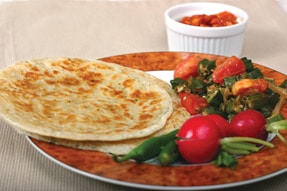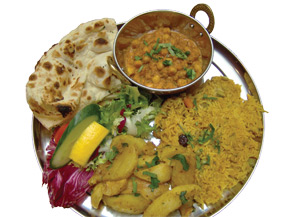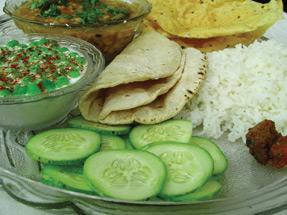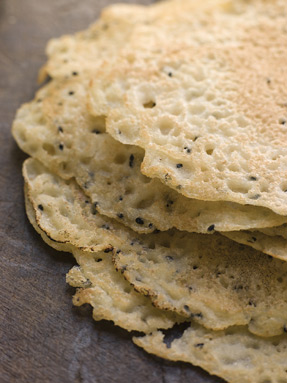Arts
Culinary Nostalgia

The powerful place food occupies in our cultural imagination.
|
Jhumpa Lahiri’s much-celebrated novel, The Namesake, famously begins with a scene in a kitchen. In her apartment in Central Square, Cambridge, Ashima Ganguli, the protagonist’s immigrant mother, combines Rice Krispies, Planters peanuts, red onion, salt, lemon juice, and green chili pepper as a “humble approximation of the snack sold for pennies on Calcutta sidewalks.” As she assembles the dish, she wishes she had some mustard oil, that necessary ingredient to make a quintessentially Bengali dish more Bengali. The absence of mustard oil in her kitchen pantry signals to the reader that Ashima Ganguli lives in a United States a few decades before Indian grocery stores dotted the landscape, from the densely populated metropolises of Chicago and New York to smaller cities in America’s homeland like Columbus, Ohio.
Indeed, Lahiri’s narrative begins in 1968, just three years after the passage of the Hart-Celler Immigration Act of 1965, a time when there were few Indians, and even fewer Indian grocery stores in the United States. This was not the US of today where chai lattes are ubiquitous and where one is not hard-pressed to find sandwiches like the tandoori chicken flatbread at Cosi, a popular sandwich restaurant chain. This was a United States in which regional ingredients like mustard oil were impossibly difficult to procure. It was a time when trips to India meant stocking up on spices and packing the loot into suitcases to bring back to the U.S. But in between trips, one had to make do with what was available, especially when it came to ingredients like oils, vegetables and meats.
Reading Lahiri’s words, one cannot help but reflect on how the passage captures the immigrant sensibility perfectly. It is beautifully suggestive of the ways in which diasporics have always had to make do with what is available. In the absence of puffed rice, one turns to Rice Krispies. In the absence of mustard oil, one gets by with canola oil. As a woman of Indian origin who grew up in various nodes of the Indian diaspora spanning from the 1970s to the present and stretching from Malaysia to Papua New Guinea and from Australia to the United States, I have always been amazed by the incredibly innovative ways in which our mothers all had a little of Ashima Ganguli in them. They longed for the tastes of home, but made do with what was available, creating new recipes along the way.
And it was with the view of understanding how culture informs our culinary choices that I set about writing a book on the topic. My book, Culinary Fictions, examines what food means in diasporic literatures of South Asia. It strives to understand the powerful place food occupies in our cultural imagination while implicitly engaging the many ways in which my own experiences as a diasporic child who learned to eat Indian food everywhere but India had impacted my intellectual growth. Eating Indian food was what made me Indian and I was curious about the link between cultural identity and why we eat what we eat. Jean Brillat Savarin, French gastronome and intellectual once said, “Tell me what you eat, I’ll tell you what you are.” I wanted to probe how food forms community in various places where Indians have migrated in the late 20th century.
My earliest memories of Indian food come from my childhood in Malaysia and adolescence in Papua New Guinea. Malaysia in the late 1970s and early 1980s was a fantastic place for an immigrant family from India. In the years before the virulent anti-Indian nationalism that would set in later in the 1980s, Indian food was everywhere. The local Indian community had strongly influenced the cuisine and one of my all-time favorites was roti canai (pronounced cha-nai). Part of the pleasure of eating roti canai is watching it being made by the cooks who prepared the roti in full view of restaurant patrons. As a child, I loved to watch roti canai being whirled in the air, like a flying pancake. Typically, the dough is expertly twirled until it becomes translucently thin. After it is stretched, it is folded and cooked on a hot grill. The oily flaky bread is then served with a thin spicy curry. While roti canai was often prepared by local Tamils, the origins of the dish are not so clear. Some claim the dish is a South Indian specialty named for immigrants from Chennai; others claim that “canai” is a variant of the channa masala, popular in Northern India, while still others claim the word canai derives from the Malay word for “grind” or “knead.” Whatever its origins, it is an undeniable part of the culinary legacy of India in Malaysia and has now made its way into U.S. restaurants. Gobo, a restaurant on New York’s fashionable Upper East Side, features roti canai on its menu (though I did have to correct the waitress for pronouncing it “kanai” despite her protests that she was correct). Elegantly folded to resemble a samosa, Gobo’s roti canai tastes amazingly like the real thing even as part of me craves for the simplicity of the roti canai prepared in Malaysia.
Like Ashima Ganguli, the taste of this simple dish was able to transport me back to an earlier time and place. Eating the roti canai with my friend Sejal, I was transported to Malaysia and recalled how on weekends, my father would bring home stacks of roti layered between newspaper along with curry in plastic pouches that threatened to burst and we would greedily devour them in a matter of minutes. Yes, it was the easy availability of Indian style food in Malaysia that made it such a culinary pleasure.
When my family moved to Papua New Guinea in 1982, we left behind a bounty of Indian foods, restaurants and street food. Papua New Guinea in the 1980s and 1990s might have been an expatriate haven for Indians, but there was no restaurant culture to speak of. The immigrants there, unlike the ones to Malaysia, Singapore and Australia, were not part of a labor diaspora who worked in the service sector as restaurant workers, domestic labor, and food vendors. None of the Indians in Papua New Guinea, or PNG as we affectionately called it, were of the laboring classes per se. Arriving in the mid 1970s on, most Indians came to the newly independent nation of Papua New Guinea as part of the neo-colonial nation building apparatus. The families (and they were always families then) came to PNG on contracts as university professors, doctors, and public servants. Under this very gendered system, our fathers were all part of the imported expatriate class of white-collar workers who ostensibly came to help the nation transition into independence. In Port Moresby in the 1980s, there were few restaurants we could go to, save for the occasional hotel coffee shop, a select few Chinese restaurants and a smattering of other unremarkable restaurants. Absent from the public dining culture were any kind of Indian restaurants. Yet this absence of Indian restaurants did not translate to a poverty of Indian food. Quite to the contrary, I credit those years in PNG for introducing me to a wide range of regional Indian cuisines and for creating a hunger to know more about how people used food to think about their cultural identity. All the best Indian food was to be had in homes and dinner parties were nothing short of a major social event among the Indian community in Port Moresby. It was at these dinner parties that I learned about the various regional specialties within Indian cuisine.
Because there were so few of us, in contrast to the large Indian communities in the U.S., we were not segregated along regional lines. Among our circle of friends were families from Orissa, Kerala, Punjab, Tamil Nadu, Karnataka , Bengal, Uttar Pradesh and more. At the Singh’s home, we devoured saag and chole with roti, at the Lawrence’s we ate sambar, chicken curry, kootu and rice. At the Gupta’s we savored dal makhani and biryanis. Fish curries abounded at the Das’ home and for dessert there were always plump rasgullas, creamy rasmalai and innumerable other cloyingly sweet treats .
In addition to our Indian friends, we also became close to our Pakistani and Sri Lankan friends. My best friend Pasandi, a Sinhala, introduced me to the wide array of spicy Sinhala fare. From string hoppers and egg hoppers to mutton curry and mackerel curry, I learned how much spicier Sri Lankan food could be. Our Pakistani friends, the Choudhurys, opened their home to all during Ramadan. I would join them in breaking their fast with dates and pistachios and then on Eid-ul-Fitr we would swoon over Aunty Naseem’s delicious kebabs and so many other resplendent delights. Food and love were never in short supply in their home. On weekends when we weren’t at dinner parties, my palate was exposed to a range of culinary specialties. Though both Kannadiga Brahmins, my father’s north Karnataka roots and preference for wheat often did not blend with my mother’s upbringing with coastal Karnataka cuisine, heavy on coconut and rice. Meals in my home were an eclectic combination of northern and southern food. No meal was complete without both chapatti and rice; we preferred moong dal or rasam to sambar. We almost never had coconut in our curries — it is the one concession my mother makes to my father’s northern Karnatakan taste buds that share more in common with Maharashtra than the rest of the state. And once a week we would eat chicken. On special occasions, we would have puran poli made from scratch, or gulab jamuns laboriously prepared in our tiny kitchen. Sometimes we would have dosas and idlis with homemade chutney. Whatever we lacked in terms of a public dining culture was compensated by the rich array of home-cooked meals, full of regional Indian accents. It is a testament to the vital interaction among diasporic communities that our mothers enriched all of our palates and knowledge of regional South Asian cuisines through this ritual of the weekend dinner parties. Looking back on that history, it was that time and place that made me want to pursue the question about how food was linked to cultural identity for Indians in diaspora. Everything I learned about being Indian was based on a diasporic upbringing and as I started to read novels of the Indian diaspora, I was intrigued by the role food played in creating or destabilizing a sense of place and identity.
I came to the United States in 1993 and left much of this vibrant desi community behind. Unlike desis raised in the United States, I have never had the same kind access to home cooking. I’ve had to rely on Indian restaurants for foods outside of my family’s repertoire and that has meant I have lost access to many of the regional culinary delights I took for granted in PNG. I’ve had to rely much more on restaurants and there’s inevitably something lost in that process. In the small town in Ohio where I teach, there is one Indian restaurant with a second on the way. And yet I still crave Indian food that I can’t find in Indian restaurants.
But there is a wonderful richness to food in public spaces in the U.S. In almost any major North American city, the vibrant ethnic neighborhoods have been a mainstay for the immigrant Indian community. As a college student in Wisconsin, close proximity to Chicago meant that Devon Street was never more than a car ride away. Sunday pilgrimages to Devon (or as the locals pronounced it, “Divan”) took a familiar pattern: lunch at one of the innumerable all-you-can-eat buffets followed by a trip to Patel Brothers to buy dhania, ginger, eggplant, methi — fresh produce that would put any local farmer’s market to shame.
When I moved to the East Coast, taking the No. 7 subway to Roosevelt Avenue in Jackson Heights replaced the monthly drives into Chicago. The throngs of people meandering through the crowded streets and then nudging their way through the packed grocery stores only added to the overall feeling of community. Indeed, this was a “Little India” where for a few hours a week one could walk through the streets of New York and feel an uncanny sense of belonging because of the ways in which ones senses were activated to experience the smells, tastes and sounds of crowded streets in India.
Anthropologist Purnima Mankekar’s research on Indian grocery stores notes, “Through the ways in which Indian grocery stores produce a sense of familiarity or their customers, they provide them not just with the spices, lentils, and other ingredients deemed crucial to Indian cooking, they also make available a range of objects, artifacts, images and discourses for consumption.” One of the storeowners Mankekar interviews succinctly notes, “People don’t just come here to buy groceries. They come for the whole package. They come for India shopping.” In Culinary Fictions, I argue that the power of nostalgia is very much embedded in these frequent visits to the Little Indias that dot the U.S. landscape. But not everyone necessarily feels “at home” in these spaces. Though comforting to many, there are ways in which these spaces can sometimes feel uncomfortable precisely because they appear to not fit a standard expectation of what Indian means. In addition to the grocery stores and the Little Indias, a newer form of food culture has emerged in urban spaces densely populated by Indians. NY Dosas has been a fixture in Washington Square Park for some years now. The unremarkable looking food cart boasts the best dosas in the U.S. And the lines that form there at lunch time offer testimony to the boast. Though popular among Indians and non-Indians alike, the humble dosa cart in which the vendor makes fresh dosas in front of his customers is a reminder of the kind of street food one might find in Indian streets, and a welcome addition to the culinary landscape of urban street food.
The traditional dosas served at NY Dosas contrast with the fusion-style dosas that are the mainstay of L.A Dosatruck. With menu items such as “Slumdog” — a dosa which includes Indian “pesto” rubbed inside the dosa with paneer, fresh spinach and masala dosa potatoes — or “Shiva’s Garden,” an offering of “avocado, caramelized onions, baby heirloom tomatoes” in a dosa and Ganesha’s Gluttony, a dosa stuffed with black olive tapenade, feta cheese, Baby Heirloom Tomatoes, Spinach,” this is not your average dosa.
The more time I spend in the U.S., the more I want to travel the country and see how Indian food has become more of a presence in unusual spaces. Whether they are grocery stores in strip malls in the Midwest, or food vendors in busy cities, Indian food is definitely more visible in the public culture of the U.S. And, if the dosa trucks are any indication, they are also reimagining Indian food in exciting new ways. But at the end of the day we still have to come home. As I get older, I find myself turning away from the wide assortment of food available in public venues and thinking about ways to share Indian food with my friends. And when I cook, I find myself returning, not to my Kannadiga roots, but to those regional flavors that I learned to love as a child. It always made sense for me to eat dal one day, and sambar the next. My taste buds travel from Kerala to Bombay and back to Mangalore. So in this information age, I turn to the Internet and cookbooks to recreate some of the tastes I learned to love in my childhood. A few months ago, a Bengali American friend from Colorado shared a recipe that I only know as “Nila’s Mom’s Potatoes.” I had most of the requisite ingredients in my kitchen — asafetida, amchur. The only thing missing was mustard oil. Without a second’s hesitation, I got into my car and drove the 5 minutes to the nearest Patel Brothers. Twenty-five minutes later, I was back in my kitchen and armed with all the necessary ingredients to make this homey Bengali-inspired dish. I think of a time not too long ago when I would have had to make do with another oil and lose the nutty pungency the mustard oil adds to the potatoes.
I am reminded of the Ashima Gangulis of the world and think how much easier it has become for my generation and the ones that follow to recreate the tastes of home in our kitchens simply because the once hard to find ingredients are literally at our fingertips. I cannot help but think and hope that Ashima Ganguli would smile at this story about a South Indian girl who craved a little taste of Bengali food and was able to find the mustard oil to make that meal just perfect.
Anita Mannur is author of Culinary Fictions: Food in South Asian Diasporic Culture (Temple University Press, 2010).
|








